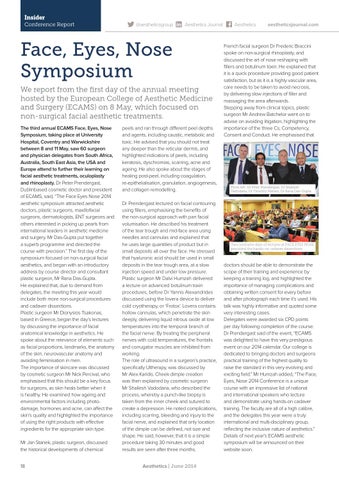Insider Conference Report
@aestheticsgroup
Aesthetics Journal
Face, Eyes, Nose Symposium We report from the first day of the annual meeting hosted by the European College of Aesthetic Medicine and Surgery (ECAMS) on 8 May, which focused on non-surgical facial aesthetic treatments. The third annual ECAMS Face, Eyes, Nose Symposium, taking place at University Hospital, Coventry and Warwickshire between 8 and 11 May, saw 60 surgeon and physician delegates from South Africa, Australia, South East Asia, the USA and Europe attend to further their learning on facial aesthetic treatments, oculoplasty and rhinoplasty. Dr Peter Prendergast, Dublinbased cosmetic doctor and president of ECAMS, said, “The Face Eyes Nose 2014 aesthetic symposium attracted aesthetic doctors, plastic surgeons, maxillofacial surgeons, dermatologists, ENT surgeons and others interested in picking up pearls from international leaders in aesthetic medicine and surgery. Mr Das-Gupta put together a superb programme and directed the course with precision.” The first day of the symposium focused on non-surgical facial aesthetics, and began with an introductory address by course director and consultant plastic surgeon, Mr Rana Das-Gupta. He explained that, due to demand from delegates, the meeting this year would include both more non-surgical procedures and cadaver dissections. Plastic surgeon Mr Dionysios Tsakonas, based in Greece, began the day’s lectures by discussing the importance of facial anatomical knowledge in aesthetics. He spoke about the relevance of elements such as facial proportions, landmarks, the anatomy of the skin, neurovascular anatomy and avoiding feminisation in men. The importance of skincare was discussed by cosmetic surgeon Mr Nick Percival, who emphasised that this should be a key focus for surgeons, as skin heals better when it is healthy. He examined how ageing and environmental factors including photodamage, hormones and acne, can affect the skin’s quality and highlighted the importance of using the right products with effective ingredients for the appropriate skin type. Mr Jan Stanek, plastic surgeon, discussed the historical developments of chemical 18
peels and ran through different peel depths and agents, including caustic, metabolic and toxic. He advised that you should not treat any deeper than the reticular dermis, and highlighted indications of peels, including keratosis, dyschromias, scarring, acne and ageing. He also spoke about the stages of healing post-peel, including coagulation, re-epithelialisation, granulation, angiogenesis, and collagen remodelling. Dr Prendergast lectured on facial contouring using fillers, emphasising the benefits of the non-surgical approach with pan facial volumisation. He described his treatment of the tear trough and mid-face area using needles and cannulas and explained that he uses large quantities of product but in small deposits all over the face. He stressed that hyaluronic acid should be used in small deposits in the tear trough area, at a slow injection speed and under low pressure. Plastic surgeon Mr Dalvi Humzah delivered a lecture on advanced botulinum toxin procedures, before Dr Yannis Alexandrides discussed using the Iovera device to deliver cold cryotherapy, or ‘Frotox’. Lovera contains hollow cannulas, which penetrate the skin deeply, delivering liquid nitrous oxide at low temperatures into the temporal branch of the facial nerve. By treating the peripheral nerves with cold temperatures, the frontalis and corrugator muscles are inhibited from working. The role of ultrasound in a surgeon’s practice, specifically Ultherapy, was discussed by Mr Alex Karidis. Cheek dimple creation was then explained by cosmetic surgeon Mr Shailesh Vadodaria, who described the process, whereby a punch-like biopsy is taken from the inner cheek and sutured to create a depression. He noted complications, including scarring, bleeding and injury to the facial nerve, and explained that only location of the dimple can be defined, not size and shape. He said, however, that it is a simple procedure taking 30 minutes and good results are seen after three months. Aesthetics | June 2014
Aesthetics
aestheticsjournal.com
French facial surgeon Dr Frederic Braccini spoke on non-surgical rhinoplasty, and discussed the art of nose reshaping with fillers and botulinum toxin. He explained that it is a quick procedure providing good patient satisfaction, but as it is a highly vascular area, care needs to be taken to avoid necrosis, by delivering slow injections of filler and massaging the area afterwards. Stepping away from clinical topics, plastic surgeon Mr Andrew Batchelor went on to advise on avoiding litigation, highlighting the importance of the three Cs; Competency, Consent and Conduct. He emphasised that
From left: Dr Peter Prendergast, Dr Shailesh Vadodaria, Dr Timothy Marten, Dr Rana Das-Gupta
Two intensive days of lectures at FACE EYES NOSE preceded the hands-on cadaver dissections
doctors should be able to demonstrate the scope of their training and experience by keeping a training log, and highlighted the importance of managing complications and obtaining written consent for every before and after photograph each time it’s used. His talk was highly informative and quoted some very interesting cases. Delegates were awarded six CPD points per day following completion of the course. Dr Prendergast said of the event, “ECAMS was delighted to have this very prestigious event on our 2014 calendar. Our college is dedicated to bringing doctors and surgeons practical training of the highest quality to raise the standard in this very evolving and exciting field.” Mr Humzah added, “The Face, Eyes, Nose 2014 Conference is a unique course with an impressive list of national and international speakers who lecture and demonstrate using hands-on cadaver training. The faculty are all of a high calibre, and the delegates this year were a truly international and multi-disciplinary group, reflecting the inclusive nature of aesthetics.” Details of next year’s ECAMS aesthetic symposium will be announced on their website soon.
